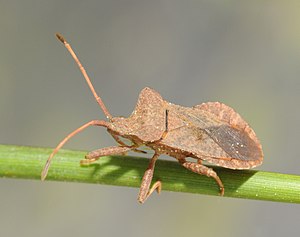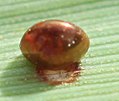Leather bug
| Leather bug | ||||||||||||
|---|---|---|---|---|---|---|---|---|---|---|---|---|

Leather bug ( Coreus marginatus ) |
||||||||||||
| Systematics | ||||||||||||
|
||||||||||||
| Scientific name | ||||||||||||
| Coreus marginatus | ||||||||||||
| ( Linnaeus , 1758) |
The leather bug ( Coreus marginatus ), also known as the large border bug or hem bug , belongs to the family of border bugs (Coreidae).
features
It becomes about 10.5 to 16 millimeters long, the edges of the abdomen protrude sideways under the wings. It is named for its leathery, medium to dark brown appearance, which turns black-brown in autumn. Your body surface is rough. It smells of apples. In flight you can see the bright red back of the abdomen.
It can be confused with Enoplops scapha or the rhombus bug ( Syromastus rhombeus ).
Way of life
The leather bug lives on trees and bushes in spring, from around April. Eggs are laid on various dock and knotweed species in May to June. The larvae that hatch after three to five weeks first suckle on the leaves and later on the fruits. From July onwards, after five stages of development, the new imago can be found both on the sucking plants in their stages of development, as well as on hedge shrubs (blackberries), various perennials (including tansy ) and thistles , as well as fireweed . The sucking acts leave conspicuous circular red spots on the large-leaved dock species. The bug can squirt its venom. It colors human skin brown, similar to the defense gland secretion of the great dead beetle . It winters in sheltered places in the litter. It occurs in Europe and Siberia .
gallery
Video recording of a leather bug
literature
- Peter Scheffel, Bernd Scheiba: Urania-Naturführer Tiere , Urania-Verlag, Leipzig, Berlin, Jena, 1st edition 1991; ISBN 3-332-00402-6 .
- Michael Lohmann: Beetles, dragonflies and other insects , BLV Verlagsgesellschaft, Munich, 1995; ISBN 3-405-14727-1 .
- Heiko Bellmann : Insects - Recognize & Determine , Mosaik Verlag, Munich, 2002; ISBN 3-576-11476-9 .
- E. Wachmann , A. Melber & J. Deckert (2007), Bugs 3 - Tierw. Deutschlds., 78, pp. 208-211, ISBN 978-3-937783-29-1 .
- Siegfried Rietschel, insects - beetles, dragonflies and others , BLV Verlagsgesellschaft, Munich, 2002, ISBN 3-405-16295-5 .
- Frieder Sauer : Bugs and cicadas , Fauna-Verlag, Karlsfeld 1996, ISBN 3-923010-12-5 .






